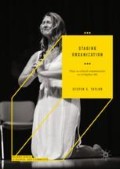Abstract
The question I get asked about my plays more often than any other is about how I use them in the classroom. So, with the caveat that there are more ways to use plays within the classroom than I can discuss here or even imagine, I offer a brief bit of scaffolding for thinking about using plays in management education. I see plays as being a way to explore the actuality—the richness, the contradictions, the complexity—of an organization, much in the way that cases or films (e.g. Champoux 1999) are used. I see a continuum of how we can ask students to engage with plays, starting with simply reading the play on their own, to collectively reading the plays out loud, to minimal rehearsal , script-in-hand performances, to full performances, to writing their own plays. Each move along the continuum requires more time and commitment from everyone involved and I would like to think each move brings deeper engagement with the subject matter.
Access this chapter
Tax calculation will be finalised at checkout
Purchases are for personal use only
References
Austin, J.L. 1962. How to do things with words. Oxford: Clarendon Press.
Austin, R., & Devin, L. 2003. Artful making: What managers need to know about how artists work. New York: Financial Times Prentice Hall.
Campbell, J. 1949. The hero with a thousand faces. NY: Princeton/Bollingen.
Champoux, J.E. 1999. Film as a teaching resource. Journal of Management Inquiry, 8(2): 206–217.
Clurman, H. 1972. On directing. New York: Collier Books.
Dunham, L., & Freeman, R.E. 2000. There is business like show business:: Leadership lessons from the theater. Organizational Dynamics, 29(2): 108–122.
Ferris, W.P. 2002. Theater tools for team building: How an improvisational play got one software team back on track. Harvard Business Review, 80(12): 24–25.
Field, S. 1982. Screenplay: The foundations of screenwriting. New York: Dell.
Freytag, G. 1922. Die Technik des Dramas. 13. Aufl. Leipzig: 170–184.
Searle, J.R. 1969. Speech acts. Cambridge: Cambridge University Press.
Stanislavski, C. 1936. An actor prepares (E.R. Hapgood, Trans.). New York: Routledge.
Taylor, S.S. 2008. Theatrical Performance as Unfreezing: Ties That Bind at the Academy of Management. Journal of Management Inquiry, 17(4): 398–406.
Author information
Authors and Affiliations
Corresponding author
Rights and permissions
Copyright information
© 2018 The Author(s)
About this chapter
Cite this chapter
Taylor, S.S. (2018). Using Plays. In: Staging Organization. Palgrave Studies in Business, Arts and Humanities. Palgrave Macmillan, Cham. https://doi.org/10.1007/978-3-319-63127-1_9
Download citation
DOI: https://doi.org/10.1007/978-3-319-63127-1_9
Published:
Publisher Name: Palgrave Macmillan, Cham
Print ISBN: 978-3-319-63126-4
Online ISBN: 978-3-319-63127-1
eBook Packages: Business and ManagementBusiness and Management (R0)

